Eclipses come in many forms
Here’s why solar and lunar eclipses happen, and how they differ from occultations and transits
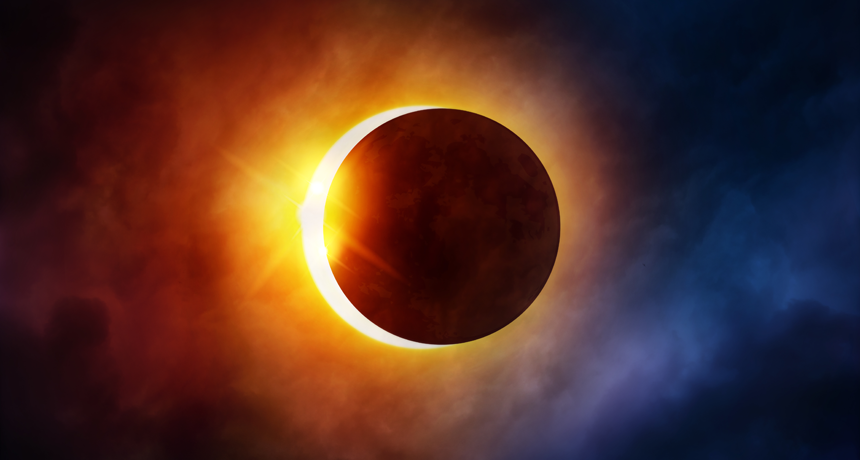
A solar eclipse (seen here in an illustration) is one of Nature’s most awesome spectacles. It occurs when, as viewed from Earth, the moon passes in front of the sun.
solarseven/iStockphoto
By Sid Perkins
Amazing things happen in the heavens. In the hearts of distant galaxies, black holes swallow stars. Once every 20 years or so, on average, a star somewhere in our Milky Way galaxy explodes. For a few days, that supernova will outshine entire galaxies in our night sky. Near our solar system, things are thankfully quiet.
Nevertheless, awesome events happen in our neighborhood too.
Eclipse means to overshadow. And that’s exactly what happens during a solar or lunar eclipse. These celestial events take place when the sun, moon and Earth briefly make a straight (or very nearly straight) line in space. Then one of them will be fully or partially shrouded by another’s shadow. Similar events, called occultations and transits, occur when stars, planets, and moons line up in much the same way.
Scientists have a good handle on how planets and moons move through the sky. So these events are very predictable. If the weather cooperates, these events easily can be seen with the unaided eye or simple instruments. Eclipses and related phenomena are fun to watch. They also provide scientists with rare opportunities to make important observations. For instance, they can help to measure objects in our solar system and observe the sun’s atmosphere.
Solar eclipses
Our moon is, on average, about 3,476 kilometers (2,160 miles) in diameter. The sun is a whopping 400 times that diameter. But because the sun is also about 400 times further from Earth than the moon is, both the sun and moon appear to be about the same size. That means that at some points in its orbit, the moon can entirely block the sun’s light from reaching Earth. That’s known as a total solar eclipse.
This can happen only when there is a new moon, the phase that appears fully dark to us on Earth as it moves across the sky. This happens about once per month. Actually, the average time between new moons is 29 days, 12 hours, 44 minutes and 3 seconds. Maybe you’re thinking: That’s an awfully precise number. But it’s that precision that let’s astronomers predict when an eclipse will occur, even many years ahead of time.
So why doesn’t a total solar eclipse occur each and every new moon? It has to do with the moon’s orbit. It is slightly tilted, compared to Earth’s. Most new moons trace a path through the sky that passes near to — but not over — the sun.
Sometimes the new moon eclipses only part of the sun.
The moon creates a cone-shaped shadow. The totally dark part of that cone is known as the umbra. And sometimes that umbra doesn’t quite reach Earth’s surface. In that case, people along the center of the path of that shadow don’t see a totally darkened sun. Instead, a ring of light surrounds the moon. This ring of light is called an annulus (AN-yu-luss). Scientists call these events annular eclipses.
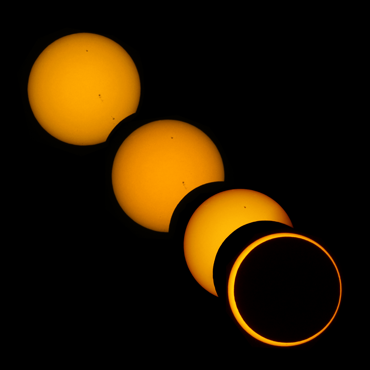
Not all people, of course, will be directly in the center path of an annular eclipse. Those inside the lighter outer part of the shadow, the antumbra, will see the moon’s silhouette surrounded by a ring of sunlight. The antumbra is also shaped like a cone in space. The umbra and antumbra are lined up in space but point in opposite directions, and their tips meet at a single point.
Why won’t the umbra reach Earth every time there’s a solar eclipse? Again, it’s due to the moon’s orbit. Its path around Earth isn’t a perfect circle. It’s a somewhat squished circle, known as an ellipse. At the closest point in its orbit, the moon is about 362,600 kilometers (225,300 miles) from Earth. At its farthest, the moon is some 400,000 kilometers away. That difference is enough to make how big the moon looks from Earth vary. So, when the new moon passes in front of the sun and is also located in a distant part of its orbit, it won’t be quite big enough to completely block the sun.
These orbital variations also explain why some total solar eclipses last longer than others. When the moon is further from Earth, the point of its shadow can create an eclipse lasting less than 1 second. But when the moon passes in front of the sun and is also at its closest to Earth, the moon’s shadow is up to 267 kilometers (166 miles) wide. In that case, the total eclipse, as seen from one spot along the shadow’s path, lasts a little more than 7 minutes.
The moon is round, so its shadow creates a dark circle or oval on Earth’s surface. Where someone is within that shadow also affects how long their solar blackout lasts. People in the center of the shadow’s path get a longer eclipse than do people near the edge of the path.
Story continues below image.
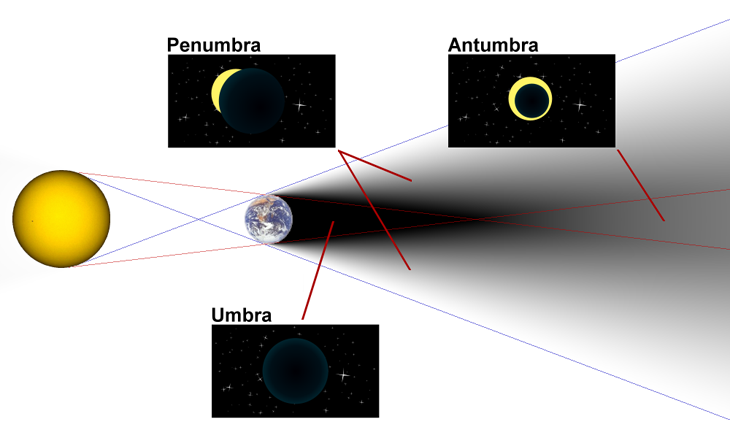
Partial eclipses
People completely outside the path of the moon’s shadow, but within a few thousand kilometers on either side of it, can see what’s known as a partial solar eclipse. That’s because they’re within the partially lit portion of the moon’s shadow, the penumbra. For them, only a fraction of the sun’s light will be blocked.
Sometimes the umbra completely misses the Earth but the penumbra, which is wider, doesn’t. In these cases, no one on Earth sees a total eclipse. But people in a few regions can witness a partial one.
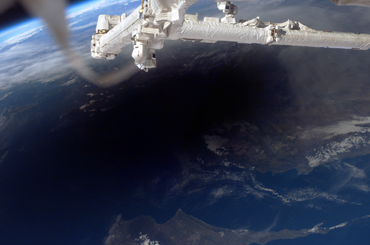
On rare occasions, a solar eclipse will start and end as an annular eclipse. But in the middle of the event, a total blackout occurs. These are known as hybrid eclipses. (The change from annular to total and then back to annular happens because Earth is round. So part of Earth’s surface will fall inside the umbra halfway through the eclipse. People in this region are almost 13,000 kilometers (8,078 miles) closer to the moon than are those at the edge of the shadow’s path. And that difference in distance can sometimes be enough to bring that spot on Earth’s surface from the antumbra into the umbra.)
Fewer than 5 in every 100 solar eclipses are hybrids. A bit more than one in three are partial eclipses. Somewhat less than one in three are annular eclipses. The rest, slightly more than one in every four, are total eclipses.
There are always between two and five solar eclipses every year. No more than two can be total eclipses — and in some years there will be none.
Why total solar eclipses excite scientists
Before scientists sent cameras and other instruments into space, total solar eclipses provided unique research opportunities to astronomers. For example, the sun is so bright that its glare normally blocks sight of its outer atmosphere, the corona. During a total solar eclipse in 1868, however, scientists collected data on the corona. They learned about the wavelengths — colors — of light it emits. (Such emissions helped identify the corona’s chemical make-up.)
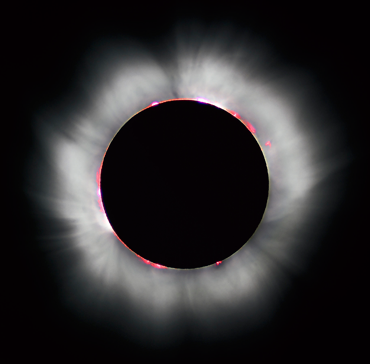
Among other things, the scientists spotted a weird yellow line. No one had seen it before. The line came from helium, which is created by reactions inside the sun and other stars. Similar studies have since identified many known elements in the solar atmosphere. But those elements exist in forms not seen on Earth — forms in which many electrons have been stripped away. These data have convinced astronomers that temperatures in the solar corona must reach millions of degrees.
Scientists also have used eclipses to look for potential planets. For instance, they’ve looked for planets that orbit the sun even closer than Mercury does. Again, the sun’s glare normally would block the ability to see anything that close to the sun, at least from Earth. (In some cases, astronomers thought they had seen such a planet. Later studies showed they had been wrong.)
In 1919, scientists gathered some of the most famous eclipse data. Astronomers took photos to see if distant stars looked out of place. If they were shifted slightly — compared to their normal positions (when the sun wasn’t in the way) — that would suggest that light zipping past the sun had been bent by its huge gravitational field. Specifically, that would provide evidence supporting Albert Einstein’s general theory of relativity. That theory had been proposed only a few years earlier. And indeed, the eclipse did provide such evidence for relativity.
Lunar eclipses
Sometimes the moon almost disappears for a short while as it falls into Earth’s shadow. Such lunar eclipses happen only at full moon, the phase when the moon is opposite the sun in our sky. It now appears as a completely lit disk. (From our vantage on Earth, it’s when the moon is rising as the sun is setting.) Just as with solar eclipses, not every full moon creates a lunar eclipse. But lunar eclipses happen more often than solar ones because Earth’s shadow is so much broader than the moon’s. In fact, Earth’s diameter is more than 3.5 times that of the moon. Being so much smaller than Earth, the moon can more easily fit completely within our planet’s umbra.
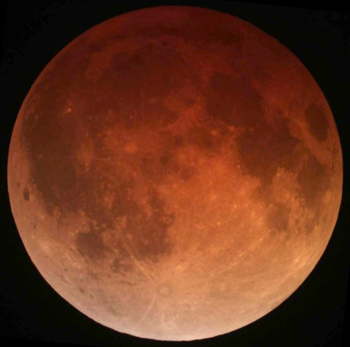
Although total solar eclipses temporarily black out only a narrow path on Earth’s surface, a total lunar eclipse can be seen from the entire nighttime half of the planet. And because Earth’s shadow is so wide, a total lunar eclipse can last up to 107 minutes. If you add in the time that the moon spends entering and leaving our planet’s penumbra, the entire event can last as much as 4 hours.
Unlike a total solar eclipse, even during a total lunar eclipse the moon remains visible. Sunlight travels through Earth’s atmosphere during the whole event, illuminating the moon in a ruddy hue.
Sometimes only a portion of the moon enters Earth’s umbra. In that case, there’s a partial lunar eclipse. That leaves a circular shadow on the moon, as if a chunk had been bitten away. And if the moon enters Earth’s penumbra but totally misses the umbra, the event is called a penumbral eclipse. This latter type of eclipse is often faint and hard to see. That’s because many portions of the penumbra are actually pretty well lit.
More than one-third of all lunar eclipses are penumbral. Some three in every 10 are partial eclipses. Total lunar eclipses make up the rest, more than one in every three.
Occultations
An occultation (AH-kul-TAY-shun) is a sort of an eclipse. Again, these happen when three celestial bodies line up in space. But during occultations, a really large object (usually the moon) moves in front of one that appears much smaller (such as a distant star).
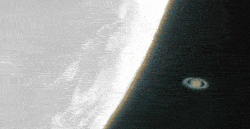
The moon has no real atmosphere to block light from behind it. That’s why some of the most scientifically interesting occultations occur when our moon moves in front of distant stars. Suddenly, the light from an object occulted by the moon disappears. It’s almost as if a light switch flicked off.
This sudden absence of light has helped scientists in many ways. First, it has let astronomers discover that what they first thought was a single star might actually be two. (They would have orbited each other so closely the scientists couldn’t separate the stars visually.) Occultations also have helped researchers better pin down distant sources of some radio waves. (Because radio waves have a long wavelength, it can be hard to tell their source by looking at that radiation alone.)
Finally, planetary scientists have used occultations to learn more about lunar topography — landscape features, such as mountains and valleys. When the ragged edge of the moon barely blocks a star, light can briefly peek through as it emerges from behind mountains and ridges. But it shine unimpeded through deep valleys that are pointed toward Earth.
On rare occasions, other planets in our solar system can pass in front of a distant star. Most such occultations don’t yield much new information. But big surprises occasionally turn up. Take 1977, when Uranus passed in front of a distant star. Scientists who meant to study the atmosphere of this gas planet noticed something weird. Light from the star flickered 5 times before the planet passed in front of the star. It flickered another five times as it was leaving the star behind. Those flickers suggested the presence of five small rings around the planet. But no one could confirm they existed until NASA’s Voyager 2 spacecraft flew by the planet nine years later, in 1986.
Even asteroids can occult the light from distant stars. Those events let astronomers measure the diameter of asteroids more accurately than with other methods. The longer that light from a star is blocked, the larger the asteroid must be. By combining observations taken from several different spots on Earth, researchers can map out the form of even oddly shaped asteroids.
Story continues below image.
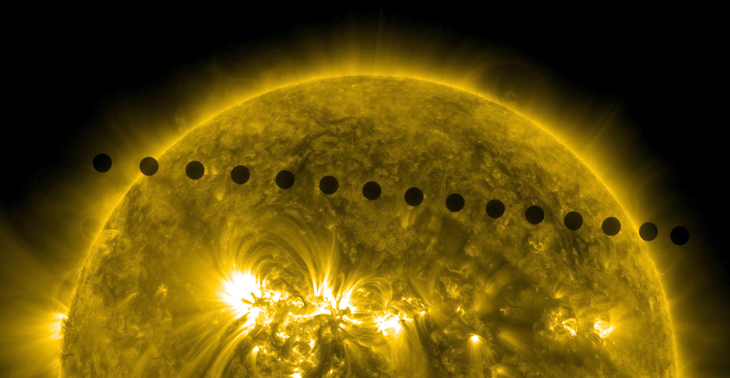
Transits
Like an occultation, a transit is a type of eclipse. Here, a small object moves in front of a distant object that appears much larger. In our solar system, only the planets Mercury and Venus can transit across the sun from Earth’s viewpoint. (That’s because the other planets are farther than us from the sun and thus can never come between us.) Some asteroids and comets, however, can transit the sun from our point of view.
Scientists have always been interested in transits. In 1639, astronomers used observations of a transit of Venus — and simple geometry — to come up with their best estimate until that time of the distance between the Earth and the sun. In 1769, British astronomers sailed halfway around the world to New Zealand to see a transit of Mercury. That event couldn’t be seen in England. From data the astronomers collected, they were able to tell that Mercury has no atmosphere.
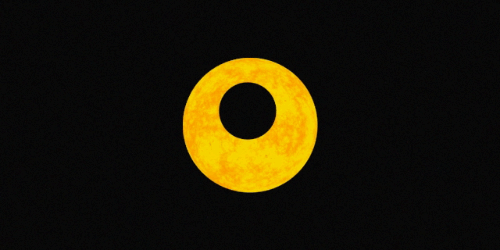
When an object passes in front of the sun, it blocks a little bit of light. Usually, because the sun is so large, much less than 1 percent of the light will be blocked. But that small change in light can be measured by ultra-sensitive instruments. In fact, a regular and repeated pattern of slight dimming is one technique that some astronomers have used to detect exoplanets — ones orbiting distant stars. The method doesn’t work for all distant solar systems, however. For transits to occur, such solar systems have to be oriented so that they appear edge-on as seen from Earth.
Corrections: This article has been corrected for one reference to a full moon that should have said new moon, and to a proportion of blocked sunlight in the last paragraph that had read more than 1 percent and now reads less than 1 percent. Finally, the section on solar eclipses has been corrected to note that people inside an antumbra will see the moon’s silhouette surrounded by a ring of sunlight (not a partially lit moon).







